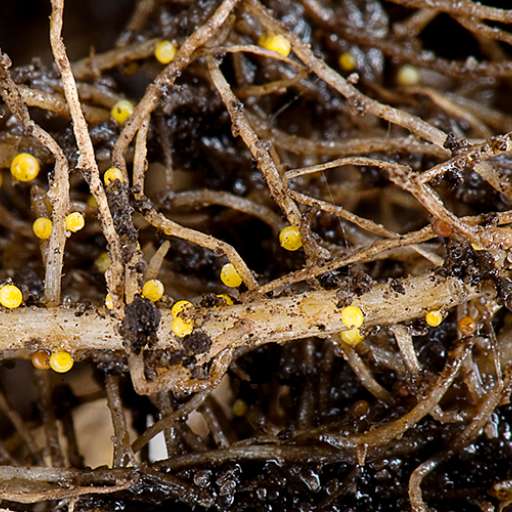
Cyst Nematode
Globodera Rostochiensis / Globodera Pallida
Pathogen:
Nematode
Type:
Risk:
HIGH




DESCRIPTION
Pathogen description
Globodera rostochiensis and Globodera pallida are parasitic nematodes that affect potato plants and other solanaceous crops. These nematodes reproduce quickly, forming cysts on the roots of the potato that can contain thousands of eggs. The larvae hatch from the cysts and feed on the roots of the potato, causing significant damage to the plant. Nematodes can survive in the soil for many years, even in the absence of their host, making them difficult to control.
Disease description
The attack of these nematodes on the roots of the potato causes the disease known as potato cyst nematode. Nematodes cause nodule formation and root damage, which affects the plant's ability to absorb water and nutrients. These damages result in limited growth, wilted leaves, and a significant reduction in tuber quality and quantity.
• Formation of nodules on the roots of the potato.
• Yellowed or wilted leaves.
• Decrease in the quality and quantity of tubers.
• Reduction in plant growth and development.

TEMPERATURE AND HUMIDITY
15°C - 25°C
60% - 80%

VOIES DE TRANSMISSION
Contaminated soil, infected plant roots, contaminated growing tools.

Chemical treatments
CONTROL
• AZADIRACTIN 1% (AS AZADIRACTIN A) [EC] P/V
• Azadirachtin 2.6% (AS AZADIRACTIN A) [EC] P/V
• 100% GARLIC EXTRACT [SC] P/V
• Garlic extract 45% [GR] P/P
• FLUOPYRAM 40% [SC] P/V
• FLUOPYRAM 50% [SC] P/V
• PHOSTIAZATE 10% [GR] P/P
• METAM POTASSIUM 57.3% [SL] P/V
• METAM SODIUM 40% [SL] P/S
• METAM SODIUM 51% [SL] P/S
Treatments authorized in organic farming
• AZADIRACTIN 1% (AS AZADIRACTIN A) [EC] P/V
• Azadirachtin 2.6% (AS AZADIRACTIN A) [EC] P/V
• 100% GARLIC EXTRACT [SC] P/V
• Garlic extract 45% [GR] P/P
Biological control
• BACILLUS FIRMUS I-1582 5% [WP] P/P
• PURPUREOCILLIUM LILACINUM (CEPA 251) 21.6% [DC] P/V
• PURPUREOCILLIUM LILACINUM (CEPA 251) 21.6% [DC] P/V
• STEINERNEMA CARPOCAPSAE (Parasitoid and predatory nematodes)
• STEINERNEMA FELTIAE (Parasitoid and predatory nematodes)
Preventive treatments
• BACILLUS FIRMUS I-1582 5% [WP] P/P
• PURPUREOCILLIUM LILACINUM (CEPA 251) 21.6% [DC] P/V
• Use potato varieties resistant to nematodes.
• Practice crop rotation with non-host plants to interrupt the life cycle of nematodes.
• Apply specific nematicidal treatments according to expert instructions.
• Improve overall plant health with proper fertilization and controlled irrigation.
• Disinfect culture tools to prevent the spread of cysts.
• Carry out soil analysis regularly to detect the presence of nematodes.
Recommendations
*The recommended treatments are recommendations based on the authorities' databases and do not replace in any way the guidelines established by the legislation of each country.





